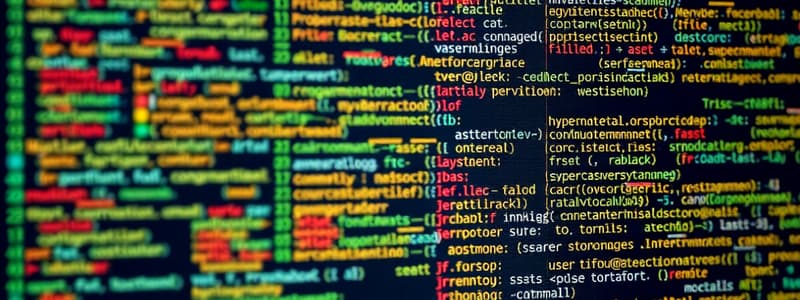Podcast
Questions and Answers
Match the programming language with its generation.
Match the programming language with its generation.
Machine Language = First Generation Assembly Language = Second Generation FORTRAN = Third Generation Query Languages = Fourth Generation
Match the language with its description.
Match the language with its description.
FORTRAN = Designed for scientific and mathematical applications. COBOL = Designed for business applications. BASIC = Developed as a simple language for students. C = Provides control and efficiency of assembly language.
Match the programming language with its appropriate use.
Match the programming language with its appropriate use.
JavaScript = Web development and interactive content. SQL = Managing and querying databases. Python = General-purpose programming and data analysis. HTML = Structuring the content of a webpage.
Match the programming language with its type.
Match the programming language with its type.
Match the markup language with its use case
Match the markup language with its use case
Match the term with its definition.
Match the term with its definition.
Match the following languages with their programming paradigms.
Match the following languages with their programming paradigms.
Categorize the languages based on whether they are more geared towards web development or system programming.
Categorize the languages based on whether they are more geared towards web development or system programming.
Match the characteristic to the appropriate generation of programming languages.
Match the characteristic to the appropriate generation of programming languages.
Match the object-oriented language with its major characteristic.
Match the object-oriented language with its major characteristic.
Match the scripting languages with their common applications
Match the scripting languages with their common applications
Match the following concepts relating to programming languages.
Match the following concepts relating to programming languages.
Match the following characteristics with the correct programming language type
Match the following characteristics with the correct programming language type
Match the language category with one of its purposes.
Match the language category with one of its purposes.
Match the definition with its relevant concept.
Match the definition with its relevant concept.
Associate the language with its use case.
Associate the language with its use case.
Associate languages with their typical execution style.
Associate languages with their typical execution style.
Associate the characteristics to a feature of programming languages.
Associate the characteristics to a feature of programming languages.
Match each term with its meaning.
Match each term with its meaning.
Associate the advantage with the language.
Associate the advantage with the language.
Associate the following terms with their place in the process.
Associate the following terms with their place in the process.
Match the category.
Match the category.
Match usage.
Match usage.
Match the concept.
Match the concept.
Associate the purpose.
Associate the purpose.
Flashcards
Programming Language
Programming Language
A set of rules that tells a computer what operations to perform.
Programming languages
Programming languages
Programming languages are a notational system for describing computation in a machine-readable and human-readable form.
Why so many languages?
Why so many languages?
Programming languages evolve as better ways are developed to designed them, different types of programs need different programming langauges.
First Generation Languages
First Generation Languages
Machine language using operation codes and operands; machine dependent and difficult to write.
Signup and view all the flashcards
Second Generation Languages
Second Generation Languages
Assembly languages use symbolic operation codes and need to be 'assembled'; more efficient and easier than machine language.
Signup and view all the flashcards
Third Generation Langauges.
Third Generation Langauges.
Closer to English with simple mathematical notation; uses source code translated into object code by a compiler.
Signup and view all the flashcards
Fourth Generation Languages (4GL)
Fourth Generation Languages (4GL)
More advanced high-level language that requires fewer instructions; often used with databases.
Signup and view all the flashcards
Fifth Generation Languages
Fifth Generation Languages
Declarative languages using functional and logic approaches; includes Lisp, Scheme, SML, and Prolog.
Signup and view all the flashcards
Two broad groups of languages
Two broad groups of languages
Traditional languages use sequences of instructions, while object-oriented languages create objects to perform actions.
Signup and view all the flashcards
FORTRAN
FORTRAN
Designed for scientific and math apps; stands for FORmula TRANslation and was developed at IBM in the mid-1950s.
Signup and view all the flashcards
COBOL
COBOL
Stands for COmmon Business-Oriented Language; developed in 1959 for business applications.
Signup and view all the flashcards
BASIC
BASIC
Beginner's All-purpose Symbolic Instruction Code; developed at Dartmouth College in the mid-1960s for students.
Signup and view all the flashcards
C language
C language
Developed by Bell Labs in the early 1970s; provides control and efficiency of assembly language with third generation features.
Signup and view all the flashcards
Simula
Simula
First object-oriented language; was developed by Ole Johan Dahl in the 1960s.
Signup and view all the flashcards
Smalltalk
Smalltalk
The first purely object-oriented language; developed by Xerox in the mid-1970s.
Signup and view all the flashcards
C++
C++
A language with additional features; wildly used for system and application software with visual programming tools.
Signup and view all the flashcards
JAVA
JAVA
An object-oriented language similar to C++ that eliminates problematic features and can be made be machine and operating system independent
Signup and view all the flashcards
Scripting Languages
Scripting Languages
Languages like JavaScript, VBScript, PHP, ASP, Perl and Python
Signup and view all the flashcards
Command Languages
Command Languages
Languages like sh, csh, and bash
Signup and view all the flashcards
Text processing Languages
Text processing Languages
Languages like LaTeX and PostScript
Signup and view all the flashcards
HTML
HTML
HyperText Markup Language; uses codes called tags in the page to indicate how the page should be formatted.
Signup and view all the flashcards
XML
XML
Extensible Markup Language used for defining other languages.
Signup and view all the flashcardsStudy Notes
Introduction to Programming Languages
- Concepts covered are:
- Definition of a programming language
- Reasons for the existence of multiple programming languages
- Types of programming languages
- The need for new languages
What is a Programming Language?
- A programming language:
- Is a set of rules that allows a computer to know what operations to perform.
- Communicates an algorithm.
- Provides a linguistic framework for describing computations.
- Is a notational system for describing computation in machine-readable and human-readable form.
- Is a tool for creating executable models for problem domains.
Why so Many Languages?
- Programming languages have evolved as better ways to design them were developed.
- The first programming languages came about in the 1950s.
- Since then, thousands of languages have been created.
- Different programming languages are designed for different programs.
Types of Languages
- The different types of programming languages are:
- First generation
- Second Generation
- Third Generation
- Fourth Generation
- Fifth Generation
First Generation Languages
- Machine language employs operation codes like addition or subtraction.
- Machine language uses operands to identify the processed data.
- It is machine dependent, as it is the only language computers understand.
- First Generation Languages are efficient, but difficult to master.
Second Generation Languages
- Assembly languages replaced binary operation codes with symbolic operation codes.
- They need to be assembled for computer execution because each instruction translates to one machine language instruction.
- Assembly languages are efficient and easier to write than First Generation Languages.
Third Generation Languages
- They are closer to English, also include simple mathematical notation.
- Programs are written in source code.
- This source code is then translated into machine language programs, also known as object code.
- The translation from source to object code is done by a compiler, a machine language system program.
- An alternative to compilation is interpretation, done by an interpreter.
- Common third generation languages:
- FORTRAN
- COBOL
- C and C++
- Visual Basic
Fourth Generation Languages
- It is a high-level language (4GL) that uses fewer instructions to complete a task than third generation languages.
- They are typically used with databases:
- Query Languages
- Report generators
- Form designers
- Application Generators
Fifth Generation Languages
- Fifth Generation Languages:
- Declarative languages
- Functional languages-Lisp, Scheme, SML, also known as applicative, and everything is a function -Logic languages-Prolog, based on mathematical logic and are rule or constraint based
Two Broad Groups of Programming Languages
- Traditional programming languages
- They have sequences of instructions
- First, second, and some third generation languages
- Object-oriented languages
- Objects are created rather than instructions sequences.
- Some third, fourth, and fifth generation languages.
Traditional Programming Languages
- FORTRAN:
- FORmula TRANslation.
- Developed at IBM in mid-1950s.
- Designed for scientific and mathematical applications,
- COBOL:
- Common Business Oriented Language.
- Developed in 1959.
- Designed to be common to many computers.
- Mainly used for business applications.
- BASIC:
- Beginner's All-purpose Symbolic Instruction Code.
- Developed at Dartmouth College in the mid-1960s.
- Designed as a simple language for students to write programs for interacting with terminals.
- C:
- Developed by Bell Laboratories in early 1970s.
- Provides control and efficiency of assembly language while having third generation language features.
- Often used for system programs.
- UNIX is written in C.
Object-Oriented Programming
- Simula:
- First object-oriented language.
- Developed by Ole Johan Dahl in the 1960s.
- Smalltalk:
- First purely object-oriented language.
- Developed by Xerox in mid-1970s.
- Still in use on some computers.
- C++:
- Additional features added to the C language.
- Commonly used for creating system and application software.
- With visual tools it is easy to develop graphical user interfaces easily
- JAVA:
- It is an object oriented language similar to C++, but eliminates C++’s problematic features.
- A developer can create programs called applets for applications that can be used via browsers.
- JAVA developers objective: make it machine, OS and platform independent.
Special Programming Languages
- Scripting:
- JavaScript and VBScript
- Php and ASP
- Perl and Python
- Command:
- sh, csh, bash
- Text processing:
- LaTex, PostScript
- HTML:
- HyperText Markup Language.
- Used on the Internet and WWW (World Wide Web).
- Web page developers use codes called tags to indicate how pages should be formatted
- XML:
- Extensible Markup Language.
- A language for defining other languages.
Studying That Suits You
Use AI to generate personalized quizzes and flashcards to suit your learning preferences.




